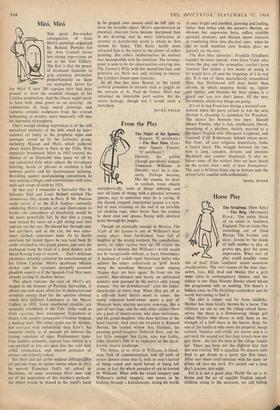Miro, MirO
One's second abiding impression is of the still unrealised enormity of the debt owed by inter- national art today to the prophetic signs and messages tossed up by the Surrealist group, including Masson and Mir& which gathered about Andre Breton in Paris in the 1920s. With impulsive brushwork Mir6 in 1925 created the illusion of an illimitable blue space set off by one calculated little white sphere. He introduced lettering, words or phrases to establish a link between poetry and his inconsequent painting. Revolting against, easel-painting conventions he was making collages and constructions with wire, nails and scraps of cloth by 1929.
In that year I remember a Surrealist film by Salvador Dali and Louis Bufiuel entitled The Andalu.sian Dog shown in Paris. If Mr. Penrose could revive it at the ICA Gallery—currently exhibiting Miret's graphic art and illustrations to books—the atmosphere of dissolution would be the more powerfully felt. In that film a young man turned his razor on a girl sitting near him and cut out her eye. He chased her through end- less corridors, and as she ran, she was some- times clothed, sometimes nude. As he finally overtook her naked figure he was held back by cords attached to two grand pianos, and over the keyboards hung the head of a dead donkey with blood flowing from its mouth.... Dali's delirious phantoms certainly coloured the consciousness of his fellow Catalan. Mir6's daydream became darker and his creatures presently assumed ghoulish aspects as if the Spanish Civil War were already casting its shadow before.
This phase remains the core of Mird's art, shaped in the ferment of Parisian Surrealism. It affects one now more often for its divination and inventive energy than for the sportive element which first titillated Londoners at the Mayor Gallery in 1933. Some smothered chuckles are naturally overheard at the Tate. Titles such as Olds covering their transparent Nakedness at Dawn with sombre rectangular Clothing bespeak a madcap poet. The visual quips can be sharper, less overcast with melancholy than Klee's. An innocent clarity as of peasant art informs the teasing repertoire of signs. Rudimentary mani- kins, ladders, crescents, vagrant lines ending in a cup-and-ball or kite are spun into the void with artful insouciance, and utmost precision of intense and primary colour.
• Yet Mire' did not arrive without difficulty.Olis art unfolds from its native source when in 1912 he entered Francisco Gall's art school in Barcelona. At some vernissage Miro once told me of. the inspiration of this teacher's methods. An object would be placed in the pupil's hand to be groped over unseen until he felt able to draw the invisible object. Mird's apprehension of essential, clear-cut form became sharpened then in his drawing, and in every fabrication in ceramic or polychrome wood to which he then turned his fancy. This basic, tactile sense attracted him at the outset to the planes of cubist painting. But cubist intellectualism he realised was incompatible with his intuition. The turning- point is seen to be the abnormalities entering into The Farmer's Wife with her monstrous feet, and primitive cat. Paris was only waiting to receive the Catalan's home-spun fantasies.
In all that has since flowed, to the recent carnival presences in ceramic such as goggle on the terraces at St. Paul de Vence, Mir6 has remained an inimitable petit maitre. He de- serves homage, though not I would think a marathon.
NEVILE WALLIS






























 Previous page
Previous page